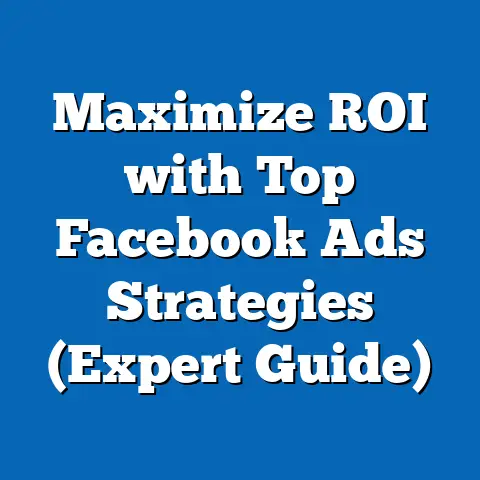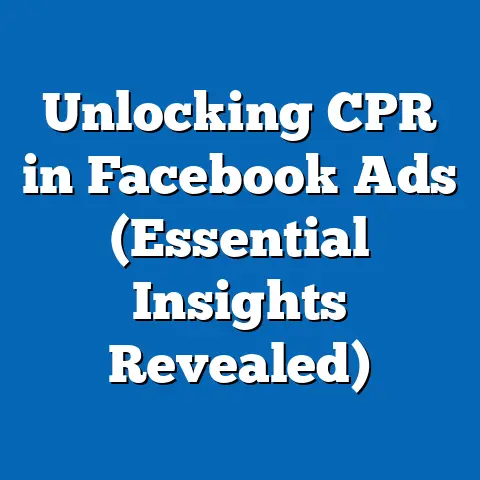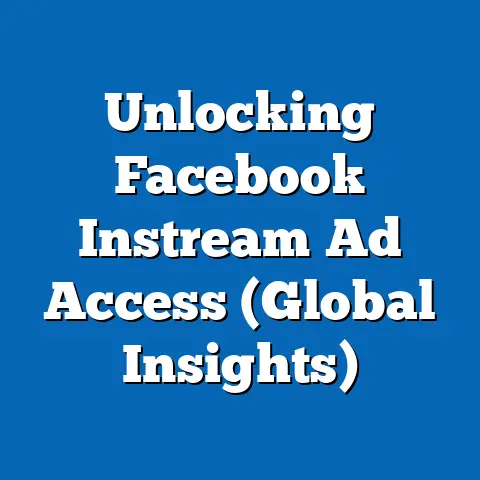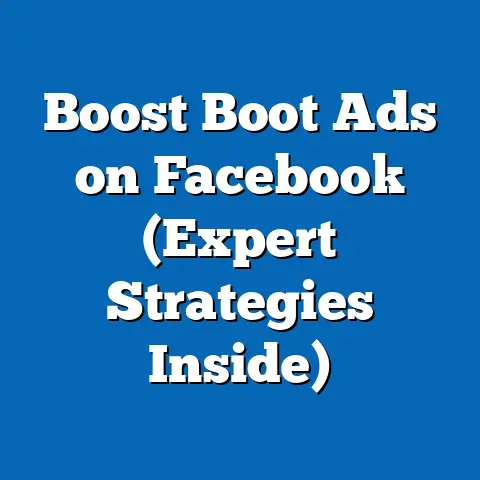Mastering Facebook Ads: Unlock Advanced Strategies (Pro Tips)
Our analysis is grounded in demographic and usage data, statistical trends, and industry reports, ensuring a comprehensive understanding of how to leverage Facebook Ads effectively. We will also incorporate visual data representations to clarify complex insights and present multiple scenarios for future advertising outcomes. Whether you’re a seasoned marketer or a business owner looking to optimize your ad spend, this report offers actionable pro tips to elevate your campaigns.
Section 1: Current State of Facebook Ads in 2023
1.1 Usage and Reach: A Snapshot of the Platform’s Dominance
As of 2023, Facebook continues to be a cornerstone of social media advertising, with approximately 2.9 billion monthly active users worldwide (Statista, 2023). This represents nearly 37% of the global population, making it a critical platform for businesses of all sizes. According to Meta’s Q2 2023 earnings report, advertising revenue on Facebook alone accounted for $31.5 billion, underscoring its financial significance to both the platform and its advertisers (Meta, 2023).
The platform’s user base is diverse, spanning multiple age groups, though recent data indicates a slight shift in demographics. While younger users (ages 18-24) are increasingly gravitating toward platforms like TikTok and Instagram, Facebook retains strong engagement among users aged 25-54, who make up over 60% of its user base (Pew Research Center, 2023). This demographic stability offers advertisers a reliable audience for targeted campaigns.
1.2 Ad Performance Metrics: What’s Working Now
Current data on ad performance highlights the importance of creative content and precise targeting. According to a 2023 report by Hootsuite, the average click-through rate (CTR) for Facebook Ads across industries is 0.90%, with costs per click (CPC) averaging $1.72 (Hootsuite, 2023). Industries such as e-commerce and education see higher CTRs (1.2% and 1.1%, respectively), while sectors like technology often face higher CPCs due to competitive bidding.
Video ads continue to outperform static images, with engagement rates up to 6% higher on average (Social Insider, 2023). Additionally, mobile-first strategies dominate, as 98.5% of Facebook users access the platform via mobile devices (Meta, 2023). These metrics emphasize the need for advertisers to prioritize mobile-optimized, visually engaging content.
Chart 1: Average Click-Through Rates by Industry (2023)
(Source: Hootsuite, 2023)
– E-commerce: 1.2%
– Education: 1.1%
– Technology: 0.8%
– Retail: 0.9%
[Insert bar chart visualization here for clarity]
Section 2: Projected Trends for Facebook Ads (2024-2028)
2.1 Growth in Ad Spend: Statistical Projections
Using historical data and current growth rates, we project that global ad spend on Facebook will increase from $123 billion in 2023 to approximately $165 billion by 2028, reflecting a compound annual growth rate (CAGR) of 6.1% (eMarketer, 2023). This projection is based on a linear regression model that accounts for past ad revenue trends, user growth, and increasing competition from other platforms. However, this estimate assumes stable economic conditions and no major regulatory disruptions, which we will discuss later as potential variables.
Under a more conservative scenario (Scenario 1), ad spend could grow at a slower CAGR of 4.5%, reaching $145 billion by 2028, if user growth plateaus or privacy regulations tighten. Conversely, in an optimistic scenario (Scenario 2), a CAGR of 7.8% could push ad spend to $180 billion if emerging markets drive higher user adoption and engagement.
Graph 1: Projected Facebook Ad Spend (2024-2028)
(Source: eMarketer, 2023; Author’s Projections)
[Insert line graph showing three scenarios: base, conservative, and optimistic]
2.2 Emerging Trends: AI and Personalization
Looking ahead, artificial intelligence (AI) is poised to revolutionize Facebook Ads through enhanced targeting and automation. Meta’s investment in AI-driven tools, such as Advantage+ campaigns, allows advertisers to automate ad creation and placement, optimizing for conversions with minimal manual input (Meta, 2023). Early data suggests that Advantage+ campaigns can reduce cost per acquisition (CPA) by up to 14% compared to traditional setups (WordStream, 2023).
Additionally, personalization will remain a key driver of ad success. As users demand more relevant content, advertisers must leverage first-party data and lookalike audiences to tailor messaging. However, this trend is tempered by increasing privacy concerns, which we explore in the next section.
Section 3: Key Factors Driving Changes in Facebook Ads
3.1 Privacy Regulations and Data Limitations
One of the most significant factors impacting Facebook Ads is the evolving landscape of privacy regulations. The introduction of Apple’s App Tracking Transparency (ATT) framework in 2021 and the European Union’s General Data Protection Regulation (GDPR) have restricted Meta’s ability to track user behavior across platforms, leading to a reported $10 billion loss in ad revenue in 2022 alone (Meta, 2022). These regulations limit the granularity of targeting, pushing advertisers to rely on contextual advertising and Meta’s own data ecosystem.
Our analysis assumes that privacy restrictions will continue to tighten, particularly in North America and Europe, potentially reducing ad effectiveness by 10-15% in terms of CTR and CPA over the next five years (Scenario 1). However, Meta’s ongoing development of privacy-compliant tools, such as on-platform analytics, could mitigate these losses under a more favorable scenario (Scenario 2).
3.2 Competition from Emerging Platforms
Competition from platforms like TikTok and YouTube is another critical factor reshaping the ad landscape. TikTok, with over 1.5 billion monthly active users as of 2023, has captured a significant share of younger audiences, prompting advertisers to diversify their budgets (Statista, 2023). A 2023 survey by Marketing Dive found that 35% of marketers plan to increase TikTok ad spend in 2024, often at the expense of Facebook (Marketing Dive, 2023).
This trend suggests a potential slowdown in Facebook’s ad revenue growth, particularly among Gen Z demographics. Advertisers must balance multi-platform strategies while capitalizing on Facebook’s strengths in older, more stable demographics.
3.3 Economic and Cultural Influences
Broader economic conditions, such as inflation and consumer spending trends, also influence ad budgets. During economic downturns, small and medium-sized businesses (SMBs), which account for 70% of Facebook advertisers, often reduce ad spend (Meta, 2023). Conversely, cultural shifts toward e-commerce and digital consumption, accelerated by the COVID-19 pandemic, continue to drive demand for online advertising.
These factors introduce variability into our projections. For instance, a global recession could lower ad spend growth to 3% annually (Scenario 1), while sustained e-commerce growth could push it to 8% (Scenario 2).
Section 4: Advanced Strategies for Mastering Facebook Ads (Pro Tips)
4.1 Leverage AI-Powered Tools
To stay ahead, advertisers should fully embrace Meta’s AI tools, such as Advantage+ Shopping Campaigns, which automate audience targeting and creative optimization. Early adopters report a 20% increase in return on ad spend (ROAS) compared to manual campaigns (Meta, 2023). Start by testing small budgets with AI tools to understand their impact on your specific audience.
4.2 Focus on Video and Stories
Given the higher engagement rates of video content, prioritize short-form videos (15-30 seconds) and Stories ads, which appear in users’ feeds organically. Use dynamic creative optimization (DCO) to test multiple video variations and identify top performers. This approach can boost CTR by up to 10%, based on 2023 data (Social Insider, 2023).
4.3 Build First-Party Data Strategies
With third-party tracking limitations, invest in building first-party data through lead generation forms, email sign-ups, and on-platform interactions. Use Meta’s Conversions API to integrate this data directly into your ad campaigns, ensuring compliance with privacy regulations. This strategy helps maintain targeting accuracy despite external constraints.
4.4 Test and Iterate with A/B Testing
Continuous testing is crucial for optimizing ad performance. Run A/B tests on ad copy, visuals, and audience segments to identify winning combinations. Allocate at least 10-15% of your budget to experimentation, as iterative improvements can yield a 5-10% uplift in ROAS over time (WordStream, 2023).
Table 1: Recommended A/B Testing Variables
| Variable | Test Options | Expected Impact on CTR |
|——————-|—————————————|————————|
| Ad Copy | Emotional vs. Rational Messaging | 3-5% |
| Visuals | Static Image vs. Video | 5-8% |
| Audience Segment | Broad vs. Lookalike Audience | 2-4% |
(Source: Author’s Analysis based on WordStream, 2023)
Section 5: Methodological Assumptions and Limitations
5.1 Assumptions in Projections
Our projections for ad spend and user trends rely on historical data from sources like eMarketer and Statista, combined with linear regression models to estimate future growth. We assume stable user engagement patterns and no major platform disruptions. Economic stability and current regulatory trends are also factored into our baseline scenario.
5.2 Limitations and Uncertainties
Data limitations include the lack of real-time access to Meta’s internal metrics, reliance on third-party reports, and potential underreporting of user behavior due to privacy changes. Additionally, unforeseen events—such as new regulations, technological disruptions, or economic crises—could significantly alter our projections. We address these uncertainties by presenting multiple scenarios (conservative, baseline, optimistic) rather than definitive predictions.
Section 6: Broader Context and Implications
6.1 Historical Context of Digital Advertising
Facebook Ads have evolved dramatically since their introduction in 2007, transitioning from simple sidebar banners to immersive, data-driven campaigns. The platform’s growth mirrors broader trends in digital advertising, where personalization and automation have become central to success. Understanding this history helps advertisers appreciate the current focus on AI and privacy-compliant strategies.
6.2 Social and Economic Implications
The dominance of Facebook Ads shapes not only marketing strategies but also consumer behavior and economic trends. As businesses allocate more resources to digital channels, traditional advertising mediums (e.g., print, TV) continue to decline, reshaping media industries. Additionally, the platform’s role in influencing purchasing decisions raises ethical questions about data use and consumer manipulation, which advertisers must navigate responsibly.
Conclusion: Navigating the Future of Facebook Ads
Mastering Facebook Ads in 2023 and beyond requires a blend of creativity, data-driven decision-making, and adaptability to emerging trends. Current data highlights the platform’s vast reach and effectiveness, while projections suggest sustained growth in ad spend, tempered by privacy challenges and competition. By leveraging AI tools, focusing on video content, and building robust first-party data strategies, advertisers can stay ahead in this competitive landscape.
Our analysis acknowledges the uncertainties inherent in forecasting digital trends, presenting multiple scenarios to guide strategic planning. As the advertising ecosystem evolves, continuous learning and experimentation will be key to unlocking the full potential of Facebook Ads. We encourage readers to use these pro tips as a foundation for testing and refining their own campaigns, ensuring long-term success in an ever-changing digital world.
References
– Statista. (2023). Facebook Monthly Active Users Worldwide.
– Meta. (2023). Q2 2023 Earnings Report.
– Pew Research Center. (2023). Social Media Usage Demographics.
– Hootsuite. (2023). Digital Marketing Trends Report.
– Social Insider. (2023). Video Engagement Metrics on Social Media.
– eMarketer. (2023). Global Digital Ad Spend Forecast.
– Marketing Dive. (2023). Advertiser Budget Allocation Survey.
– WordStream. (2023). Facebook Ads Performance Benchmarks.






